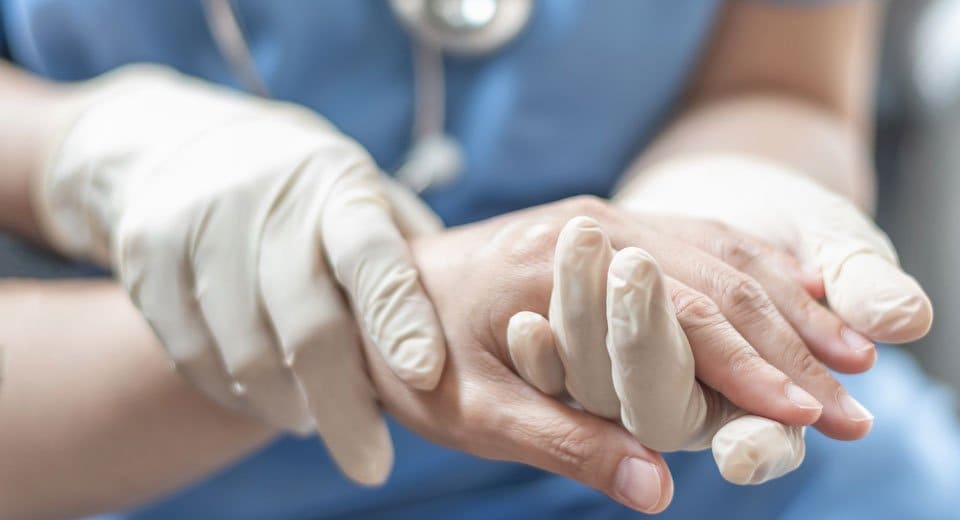After a near-severed finger, she became a first for Cape Cod

Arline North hadn’t planned to be first at anything that day; she just wanted to take her cup of coffee downstairs.
Then she slipped on her steps and fell, landing on the broken pieces of pottery and cutting herself so badly that she severed about 80 percent of the pinkie finger of her right hand, including the nerves. That led to her being the first patient at Cape Cod Hospital to receive a new type of nerve graft – an AxoGen Nerve Graft – during microsurgery performed by Hyannis hand and plastic surgeon Peter E. Bentivegna, MD, FACS.
Nerve grafts are performed using allograft – a piece of nerve tissue harvested from a patient’s body or a deceased donor. The allograft bridges a severed nerve and provides a pathway for it to regenerate. This new type, which uses specially treated tissue, is a game-changer for Cape Cod Hospital, Dr. Bentivegna said.
“This allows someone like myself, who has microsurgical training and expertise, to do this in a community setting that otherwise we would have to send off to Boston,” Dr. Bentivegna said. “This expands our high-tech capabilities at this hospital.”
A severed nerve wants to grow, he said. “The reason why we’ve had problems in the past with some of the ways that we have repaired nerves is that we haven’t given the nerves anywhere to grow. When we do the grafting, it gives that nerve a place to grow and to grow into.”
Less Risky
While nerve repairs have been performed for years, they were done by connecting the severed nerve ends with a tiny pipe-like conduit or, if the gap were more than about ¾ of an inch, grafting a substitute nerve from the patient’s body or a cadaver. A graft meant general anesthesia and either a second surgical site or, in the case of the cadaver tissue, the risk of rejection or infection.
This new allograft tissue presents less of a risk and simplifies the graft procedure for doctor and patient, Dr. Bentivegna said. The nerve tissue is harvested from a donated body before it’s been embalmed and then is sterilized and radiated, he said.
“They are completely removed of any immunogenic or sensitizing types of cells that would cause a rejection problem,” he said.
“That means the architecture is preserved but there are no living cells that could cause an immune response.”
North was a perfect candidate for the new procedure partly because at 76, her age was a complicating factor for surgery, Dr. Bentivegna said.
“The issue here is that you have an older person with a nerve injury who has limited ability to heal a nerve in general. You certainly don’t want to put her into a long microsurgical procedure with donor nerves from her legs and cause more problems.”
Besides, there was no time for North to have complications, she had a deadline: A floral designer and gardener, she was due to create an arrangement for the Boston Museum of Fine Arts’ prestigious show, Art in Bloom, in late April.
After she fell on Feb. 18, she first went to the emergency room. “It was bleeding so badly,” she said. “They temporarily stitched me up and sent me to Dr. Bentivegna the next day.”
Her hour-long surgery on Feb. 26 was done under mild anesthesia. She went home later that day.
First of Many Who Could Benefit
The allograft, which comes in different lengths and sizes, allowed Dr. Bentivegna to trim back as much of North’s damaged nerve as necessary. Then, operating under the microscope, he sewed the allograft to the trimmed nerve ends, using nylon sutures smaller than the human hair. The graft creates the route for the nerve ends to regenerate toward each other, at a rate of about a millimeter a day, he said.
“The pain level really wasn’t that bad,” North said about the aftermath. The bigger challenge, she said, was living as a left-handed person for several weeks, but “I had wonderful people who were here helping.”
After surgery, she had a splint and went through physical therapy. A month out, she could feel a tingling at the tip of her finger when the surgical site was tapped – a good sign, Dr. Bentivegna said. “That tells me there is some communication through the repair to the tip of the finger,” he said.
At 10 weeks after surgery, she still had some swelling and didn’t yet have full feeling in her finger. But, she was only using her splint in the evenings and, most importantly, had made her deadline for the Museum of Fine Arts arrangement.
“I pretty much have use of the hand,” she said. “I just went out and got my deck furniture.”
Bentivegna sees her as the first of many patients who could benefit from nerve repair using the allograft, including those who suffer from painful neuromas – the result of damaged nerve cells growing in a mass after trauma or surgery.
“With the availability of the allograft, I now can be more aggressive with patients who have established nerve problems,” Dr. Bentivegna said. “This is a very good doable procedure and field of nerve repair that we can do here. How far will we take it? We’ll, we’ll have to see. There’s a lot of new things in neurosurgery going on.”
